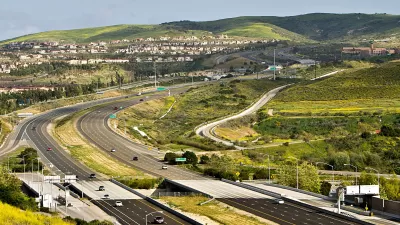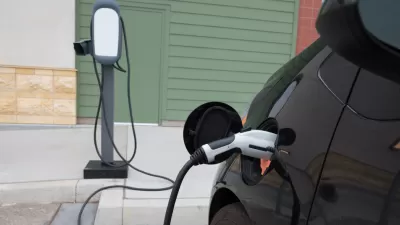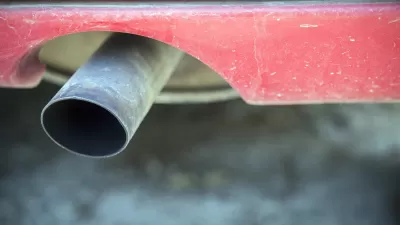A new economics report from Beacon Economics for Next 10 shows that what good for the environment is good for the state's economy, but the results are marred by increasing vehicle-miles-traveled. The state's housing crisis is partly to blame.

A report from the non-profit group Next 10 released August 22 closely mirrors the 2017 Edition: California Greenhouse Gas (GHG) Emission Inventory released by the California Air Resources Board (CARB) last June. Both reports show that reducing greenhouse gas emissions and an improving economy go hand-in-hand.
Next 10's 2017 California Green Innovation Index "continues to track key environmental and economic indicators at the regional, state, and national levels, but with a renewed focus on California's role as a global leader of climate policy and innovation," according to the nonprofit group's webpage on it ninth annual report on the index.
Like CARB's GHG inventory, it finds that the the state's gross domestic product (GDP) increases as emissions per capita decrease. The increased state regulations and incentives on energy efficiency and renewable energy have resulted in job growth making it a national leader in these sectors. And while transportation emissions are the exception to the glowing report, there is good news there as well:
- "By the end of 2016, about half of all zero-emission vehicles (ZEVs) ever sold in the U.S. were bought in California and in Q1 of 2017, ZEVs accounted for nearly 5 percent of the state's auto sales
- "In 2015, there were nearly 172,895 ZEVs registered in California, up 45.5 percent from 2014, and traditional gasoline vehicle registration increased 1.7 percent over the same period"
"In that arena, the Los Angeles-Orange County area is leading the charge," reports Lauren Williams for the Orange County Register.
The index found that the Los Angeles-Long Beach-Anaheim area ranked highest in the state in the number of clean vehicle rebates with 17,595 in 2016, a small decline from 2015. The region was followed closely by the San Francisco and San Jose metro areas.
Transportation is the 'D' in the report card filled with 'A's
One can't emphasize enough how much the state's auto-dependence is setting back progress in emissions reductions. Fortunately, the media held no punches in interpreting the report.
- "California has a climate problem, and its name is cars," is Vox's headline on the index.
- "California’s Car Culture Is Slowing the State's Emissions Cuts," is how InsideClimate News described it.
- The Register recognized that the problem goes beyond four wheels in its title: "Report: California needs to address housing crisis to meet long-term climate change goals."
Notwithstanding the jump in ZEV sales, transportation emissions are on the rise, suppressing the state's overall improvement in emissions reduction.
"On an absolute basis, California’s total GHG emissions fell only slightly in 2015, down 0.34 percent from 2014," states Next 10's press release in Business Wire.
In 2015, total transportation-related GHG emissions rose by 2.7 percent, largely due to an increase of 3.1 percent in emissions from on-road vehicles like cars, trucks and buses.
More ZEVs the answer?
"Even as fuel efficiency has improved and electric cars have begun catching on, Californians as a whole are driving more, pushed by lower gas prices and longer commutes," reports Nicholas Kusnetz for InsideClimate News.
However, David Roberts of Vox initially describes it differently.
To put it as simply as possible: California’s experience shows that decarbonizing the electricity sector is both possible and profitable, but to reach its ambitious carbon targets, the state will now have to decarbonize transportation — which brings a whole new and daunting set of difficulties.
That said, Roberts adds, "Passenger vehicles are the problem. There are two solutions."
Pointing to a Next 10 chart [png] in ZEV registrations, he recognizes that the numbers are not rising fast enough to reach the SB 32 target of reducing emissions 40 percent below 1990 levels by 2030.
The other solution to passenger vehicles is reducing commuting times by solving that housing crisis, and getting people out of their cars by increasing infill and density via building out proper public transportation systems (which themselves will need to be electrified). Unfortunately, cheap gasoline lately has meant a decline in per capita public transportation use in almost every major California city.
Leaving the huge issue of cheap gasoline aside, the impact of the state's housing crisis can not be overstated.
"[T]he housing affordability and availability crisis is forcing people to live increasingly farther away from work, driving up total vehicle miles traveled in the state by 2.7 billion in 2014, up 0.08 percent from the previous year," said Adam Fowler, economist at Beacon Economics, an independent research and consulting firm that compiled the Index for Next 10.
"So it’s no surprise that greenhouse gas emissions from vehicles have been increasing, despite California having the nation’s most ambitious clean transportation policies.”
Liam Dillon's March piece in the Los Angeles Times, "California won't meet its climate change goals without a lot more housing density in its cities" (posted here), points to the failure of SB 375, the Sustainable Communities and Climate Protection Act of 2008, the law that directs the state's 18 metropolitan planning organization to reduce driving to meet its emissions reduction targets.
In a series of reports over the last year, climate regulators have said California needed to reduce driving by an additional 15% over what regional governments have already planned to meet the 2030 greenhouse gas targets. That means even more closely packed housing than previously anticipated will be needed.
Next 10 released a similar report in March linking infill development and emissions reduction.
Hat tip to David McCoard.

Alabama: Trump Terminates Settlements for Black Communities Harmed By Raw Sewage
Trump deemed the landmark civil rights agreement “illegal DEI and environmental justice policy.”

Study: Maui’s Plan to Convert Vacation Rentals to Long-Term Housing Could Cause Nearly $1 Billion Economic Loss
The plan would reduce visitor accommodation by 25% resulting in 1,900 jobs lost.

Planetizen Federal Action Tracker
A weekly monitor of how Trump’s orders and actions are impacting planners and planning in America.

DC Extends Application Window for Outdoor Dining Permits
District restaurants will have until the end of November to apply, but businesses with permits in rush hour parking lanes must end operations on July 31.

Wind Energy on the Rise Despite Federal Policy Reversal
The Trump administration is revoking federal support for renewable energy, but demand for new projects continues unabated.

Passengers Flock to Caltrain After Electrification
The new electric trains are running faster and more reliably, leading to strong ridership growth on the Bay Area rail system.
Urban Design for Planners 1: Software Tools
This six-course series explores essential urban design concepts using open source software and equips planners with the tools they need to participate fully in the urban design process.
Planning for Universal Design
Learn the tools for implementing Universal Design in planning regulations.
Caltrans
Smith Gee Studio
Institute for Housing and Urban Development Studies (IHS)
City of Grandview
Harvard GSD Executive Education
Toledo-Lucas County Plan Commissions
Salt Lake City
NYU Wagner Graduate School of Public Service





























